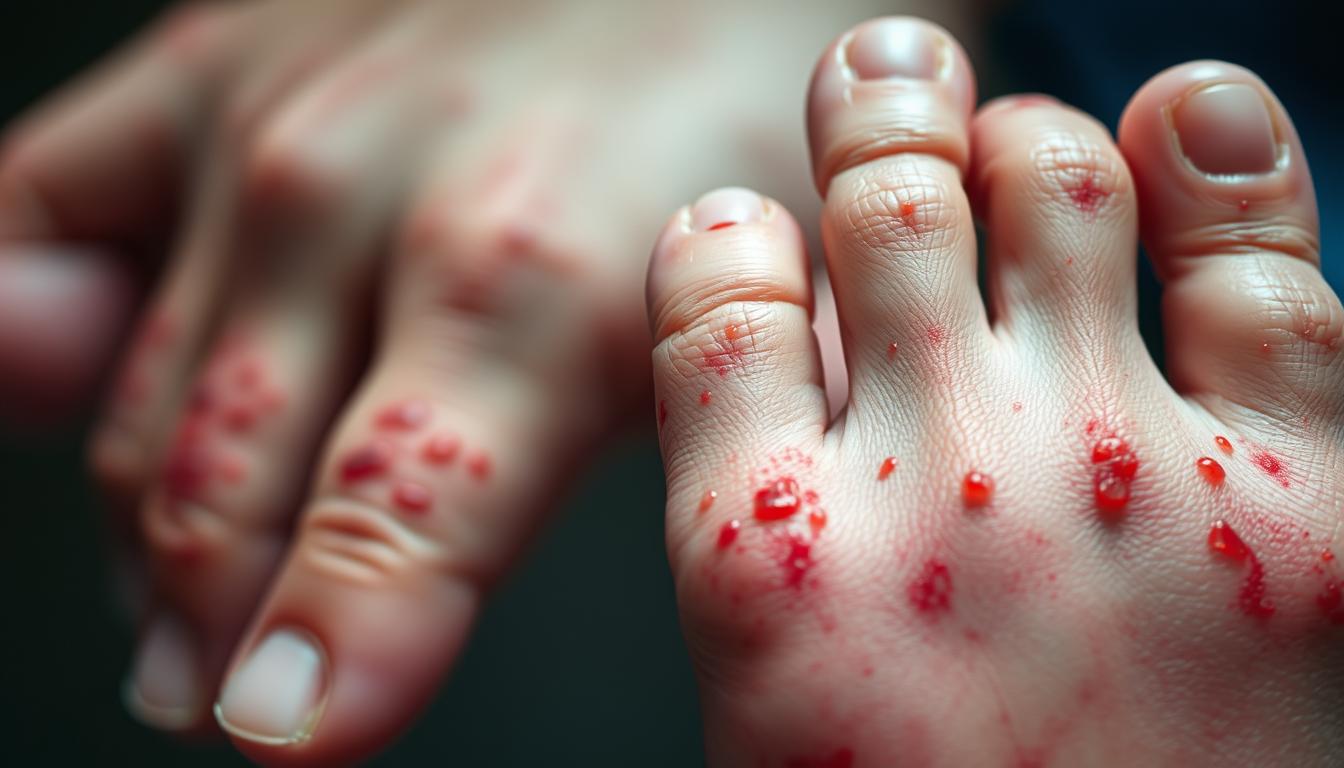Hand foot mouth disease is a common viral infection that affects both kids and adults. It’s most common in children under 5, with over 90% of cases in this age group. Many of us don’t know much about it, but it’s worth learning about.
The Mayo Clinic says it’s a mild, contagious viral infection. I’m excited to learn more about it.
Introduction to Hand Foot Mouth Disease
Hand foot mouth disease causes sores in the mouth and a rash on the hands and feet. It’s a viral infection that many families deal with. I want to understand the viral link to this condition, its causes, symptoms, treatment, and prevention.
Key Takeaways
- Hand foot mouth disease is a common viral infection that affects children and adults.
- More than 90% of cases occur in children under 5 years old.
- The viral infection is characterized by sores in the mouth and a rash on the hands and feet.
- Hand foot mouth disease is a mild, contagious viral infection.
- Understanding the causes, symptoms, treatment, and prevention is essential in managing this viral infection.
- The Mayo Clinic provides valuable information on hand foot mouth disease, including its symptoms and treatment options.
- It is important to stay hydrated and take care of yourself to prevent dehydration during the illness.
Understanding the Viral Connection: Hand, Foot, and Mouth Disease Uncovered
Hand, foot, and mouth disease (HFMD) is a common viral infection. It affects people of all ages, but mostly children under 10. The viral connection to HFMD is complex. It involves several viruses, including coxsackievirus A.
The Centers for Disease Control and Prevention say coxsackievirus A is a top cause of HFMD. It spreads through contact, contaminated surfaces, and respiratory droplets.
Coxsackievirus plays a big role in HFMD outbreaks. In recent years, cases caused by coxsackievirus A6 have increased. This strain is linked to more severe symptoms and complications. The viral connection between coxsackievirus and HFMD is complex. But research shows it’s a key factor in the disease’s spread.
Here are some key facts about the viral connection to HFMD:
- HFMD is caused by viruses, including coxsackievirus A
- Coxsackievirus A spreads through person-to-person contact, contaminated surfaces, and respiratory droplets
- Coxsackievirus A6 is a common cause of HFMD outbreaks
- HFMD can lead to complications, such as fingernail and toenail loss, in severe cases
Recognizing Early Warning Signs
Hand, foot, and mouth disease can be hard to spot early. Knowing the early warning signs helps get medical help fast. The Mayo Clinic says symptoms include fever, sore throat, and mouth blisters.
Common early warning signs are:
- Fever (99.5°F/37.5°C or higher)
- Lack of appetite
- Runny nose
- Sore throat
Seeing these symptoms means it’s time to see a doctor.

Knowing the early warning signs and symptoms helps stop the disease from spreading. It also ensures getting the right care.
Common Symptoms to Watch For
Knowing the symptoms of hand, foot, and mouth disease is key for early action. The Centers for Disease Control and Prevention say symptoms include fever, rash, and sores on hands and feet. These signs are important for quick treatment.
The disease often starts with fever and discomfort. Then, rash and sores show up. Spotting these symptoms early helps in caring for your child and avoiding worse problems.
Identifying Fever and Initial Discomfort
Children usually get fever and flu-like symptoms 3 to 5 days after getting the virus. After the fever, they might lose their appetite, have a sore throat, and feel generally unwell.
Spotting Characteristic Rashes and Sores
Mouth sores start as small red spots on the tongue and inside the mouth. They can blister and hurt. A skin rash might show up on palms, soles, buttocks, legs, and arms. It looks like flat or slightly raised red spots, sometimes with blisters.
Understanding the Disease Progression
While serious problems from HFMD are rare, knowing the risks is important. Dehydration is a big worry, mainly for young kids. Most people get better in 7 to 10 days without needing much medical help. Spotting symptoms like fever, rash, and sores is critical for caring for your child and stopping the disease from spreading.
Who’s Most at Risk for Infection
Children under 5 are most at risk for hand, foot, and mouth disease, says the Mayo Clinic. This is because risk factors like age and exposure to the 
The following groups are at a higher risk of infection:
- Children under the age of 5, specially those in childcare centers or preschools
- Individuals with weakened immune systems
- People who have not practiced good hygiene, such as frequent handwashing
It’s key to know the risk factors and take steps to stop the contagious virus spread, mainly among children. By being aware and taking preventive actions, we can keep our communities healthy and safe.
The Diagnostic Process: What to Expect
When I see my doctor for hand, foot, and mouth disease symptoms, the diagnostic process starts with a physical examination. The doctor checks my mouth, hands, and feet for signs like rashes and sores.
They might also do laboratory testing to make sure. This could be viral cultures or PCR tests.
Physical Examination Procedures
In the physical exam, the doctor looks for disease signs. They check for:
- Signs like rashes and sores on hands and feet
- Mouth sores and blisters
- Fever and other symptoms
Laboratory Testing Options
Lab tests help confirm the diagnosis and rule out other issues. These might include:
- Viral cultures
- PCR (polymerase chain reaction) tests
- Other tests to rule out other conditions
By using the diagnostic process, my doctor can accurately diagnose and suggest treatment.
Treatment Options and Home Care Strategies
The Mayo Clinic says there’s no cure for hand, foot, and mouth disease. But, treatment options can help ease symptoms. Over-the-counter meds and home care can make you feel better and avoid serious issues.
Some common treatment options include:
- Over-the-counter pain relievers, such as acetaminophen or ibuprofen
- Antihistamines to relieve itching and reduce the risk of infection
- Topical creams or ointments to soothe blisters and rashes
Along with these treatment options, home care can also help. It’s about managing symptoms and stopping the disease from spreading. This includes:
Keeping the affected area clean and dry, and using cool compresses to ease pain. It’s also key to wash hands often with soap and water. This helps stop the disease from spreading.

By using these home care tips and treatment options, you can handle symptoms well. This helps lower the chance of serious problems from hand, foot, and mouth disease.
Managing Pain and Discomfort
Managing pain is key when dealing with hand, foot, and mouth disease. The Centers for Disease Control and Prevention suggest using over-the-counter medicine like acetaminophen or ibuprofen. These can help ease pain and lower fever.
There are also natural relief options. Cold compresses, warm baths, and topical creams can soothe the skin. These methods can help reduce discomfort.
It’s important to watch how the disease progresses. If you need to, seek medical help. Here are some times when you should get medical attention:
- Severe pain or discomfort that doesn’t get better with over-the-counter medicine
- Difficulty swallowing or breathing
- Severe dehydration or signs like excessive thirst, dark urine, or less urine

Using over-the-counter medicine and natural relief methods can help manage pain. Also, getting medical help when needed is important. This way, you can handle the pain and discomfort of hand, foot, and mouth disease effectively.
Preventing Spread in Households
Hand, foot, and mouth disease spreads fast in homes, mainly among young kids. To stop it, good hygiene and reducing contact with sick people are key. The Mayo Clinic says washing hands often and avoiding sick people can stop the disease.
Important steps include washing hands with soap and water for 20 seconds. Do this after using the bathroom, before eating, and after coughing or sneezing. Also, disinfecting surfaces and objects touched by the virus helps. Use a diluted bleach solution, but make it within 24 hours for best results.
To lower spread risk, avoid close contact with sick people, even in your home. Keep sick people away from food and vulnerable groups like kids, the elderly, and those with weak immune systems. These steps can greatly lower the risk of spreading hand, foot, and mouth disease in your home.

By following these steps, homes can fight off this virus and keep everyone safe. Remember, stopping the virus early is the best way to avoid outbreaks of hand, foot, and mouth disease.
School and Daycare Considerations
Hand, foot, and mouth disease can spread quickly in school and daycare settings. The Centers for Disease Control and Prevention say kids can go back to school or daycare when they’re no longer contagious.
To stop the virus from spreading, talking to teachers and caregivers is key. Here are some important steps:
- Keep your child home from school or daycare until they’re no longer contagious.
- Tell teachers and caregivers about your child’s illness.
- Make sure everyone washes their hands often and practices good hygiene.
By following these steps, you can help keep school and daycare safe. This way, all kids can go back to school and do well in a healthy environment.

Long-term Health Implications
Long-term health issues can be serious for those who get hand, foot, and mouth disease. The Mayo Clinic says this disease is usually mild. But, in rare cases, it can lead to serious health problems.
These problems include viral meningitis and encephalitis. These are rare but can be very serious. Long-term health complications can have serious implications for individuals who experience hand, foot; and mouth disease

Building Immunity and Recovery
As I work on getting better from hand, foot, and mouth disease, I know how key it is to boost my immunity. The Centers for Disease Control and Prevention say most people get better in 7-10 days. Rest, drinking lots of water, and eating well can help my immune system recover.
Understanding the Recovery Timeline
Recovering from HFMD usually takes a few days of rest and drinking water. It’s vital to let my body fight off the virus and strengthen my immunity. I can help my immune system by sleeping well, eating healthy, and drinking lots of water.

Supporting the Immune System
To help my immune system while I’m getting better, I can do a few things:
* Rest a lot to let my body fight the infection
* Drink lots of water to stay hydrated
* Eat foods that are good for my immunity
* Keep clean to stop the virus from spreading
Myths and Misconceptions Debunked
There are many myths and misconceptions about hand foot mouth disease. The Mayo Clinic says we need to clear up these misunderstandings. One big mistake is thinking it’s linked to foot-and-mouth disease. But they are two different things.
Another myth is that poor hygiene or bad nutrition causes the disease. But the real cause is a virus, coxsackievirus A16. It spreads easily through coughing, touching, and touching surfaces. Here are some important facts:
- Approximately 200,000 cases occur annually in the U.S.
- About 90 percent of cases occur in children under the age of 10.
- The illness is most contagious during the first week of infection.
Knowing these facts helps us fight myths and misconceptions about hand foot mouth disease. By understanding the truth, we can stop it from spreading. This protects kids and older adults. 
Conclusion
As we wrap up our look at hand, foot, and mouth disease (HFMD), it’s clear we need to stay alert and take action. The is on the rise worldwide. But, with the right care and precautions, we can lessen its effects.
Knowing the , , and the value of helps us fight HFMD. Together, we can cut down its spread and impact. Healthcare experts, researchers, and public health teams are studying this virus closely. They urge us to stay alert, follow proven methods, and protect our health and that of our families.
By staying informed, keeping clean, and getting medical help when needed, we can tackle HFMD. Let’s work together to understand, manage, and prevent this common childhood illness. Let’s promote awareness, use effective strategies, and aim for a healthier community for all.
FAQ
What causes hand, foot, and mouth disease?
Hand, foot, and mouth disease is caused by viruses like Coxsackievirus A. These viruses spread through contact, surfaces, and droplets.
What are the early warning signs of hand, foot, and mouth disease?
Early signs include fever, sore throat, and mouth blisters. Spotting these symptoms early is key to treatment.
Who is most at risk for hand, foot, and mouth disease?
Anyone can get it, but kids under 5 are most at risk. It’s a contagious virus.
How is hand, foot, and mouth disease diagnosed?
Doctors check for rashes and sores. They might also do tests to confirm it.
How is hand, foot, and mouth disease treated?
Treatment is mostly about managing symptoms. Over-the-counter meds and home care help. The goal is to ease symptoms and support the immune system.
How can the spread of hand, foot, and mouth disease be prevented in households?
Preventing it is key. Wash hands often, avoid touching sick people, and clean surfaces to stop it from spreading.
What are the long-term health implications of hand, foot, and mouth disease?
It’s usually mild, but rare complications like meningitis or encephalitis can happen.
How can I build immunity and recover from hand, foot, and mouth disease?
Rest, stay hydrated, and eat well to help your body fight it off. Most people get better in 7-10 days.
Are there any myths or misconceptions about hand, foot, and mouth disease?
Yes, myths say it’s caused by poor hygiene or nutrition. It’s not true. It’s caused by viruses, not bad habits.
Source Links
- Hand, Foot, and Mouth Disease – StatPearls
- Hand-foot-and-mouth disease-Hand-foot-and-mouth disease – Diagnosis & treatment – Mayo Clinic
- Emerging Coxsackievirus A6 Causing Hand, Foot and Mouth Disease, Vietnam
- Hand-Foot-and-Mouth Disease in Adults
- What To Know About Hand, Foot and Mouth Disease
- Epidemiological and clinical characteristics of severe hand-foot-and-mouth disease (HFMD) among children: a 6-year population-based study – BMC Public Health
- HFMD Symptoms and Complications
- Hand, Foot, and Mouth Disease (HFMD)
- About Hand, Foot, and Mouth Disease
- Hand, Foot, and Mouth Disease (for Parents)
- Hand, Foot and Mouth Disease (Coxsackie viral infection)
- Hand, foot, and mouth disease in adults: Symptoms and treatment
- Hand, Foot, and Mouth Disease (HFMD)
- Current status of hand-foot-and-mouth disease
- Hand, foot and mouth disease fact sheet
- Hand-Foot-and-Mouth Disease
- Hand, foot and mouth disease
- Hand, Foot and Mouth Disease: Symptoms, Causes and Treatment
- Hand, Foot & Mouth Disease: Parent FAQs
- Centre for Health Protection, Department of Health – Hand, Foot and Mouth Disease
- Guidelines for Infectious Diseases Reporting & Exclusion 2024
- Infection Prevention and Control in Child Care Centres Requirements and Best Practices
- Lindgren Childcare Center: St. Cloud State University
- Exuberant Hand-Foot-Mouth Disease: An Immunocompetent Adult with Atypical Findings
- A five-year retrospective study on the epidemiology of hand, foot and mouth disease in Sabah, Malaysia – Scientific Reports
- Hand, Foot & Mouth Disease
- The Clinical and Epidemiological Study of Children with Hand, Foot, and Mouth Disease in Hunan, China from 2013 to 2017 – Scientific Reports
- Frontiers | Synbiotics Supplements Lower the Risk of Hand, Foot, and Mouth Disease in Children, Potentially by Providing Resistance to Gut Microbiota Dysbiosis
- Hand-foot-and-mouth disease: what you need to know
- Who’s Afraid of Hand, Foot and Mouth Disease?
- There are lots of myths about flu: we debunk six of them – NICD
- Hand, foot and mouth disease – a short case report
- Current status of hand-foot-and-mouth disease – Journal of Biomedical Science
- Hand-Foot-and-Mouth Disease (HFMD): Practice Essentials, Background, Pathophysiology



